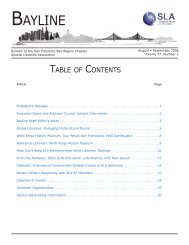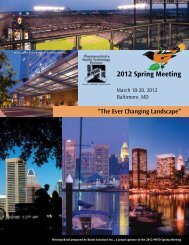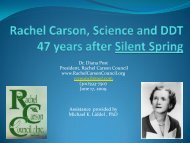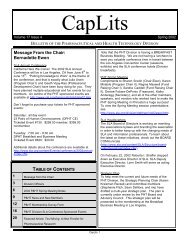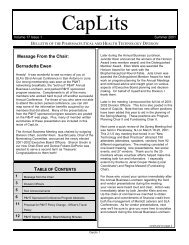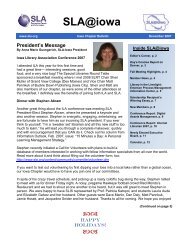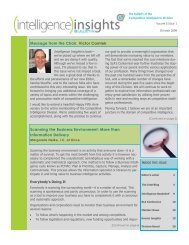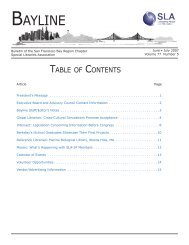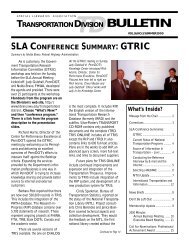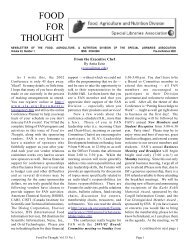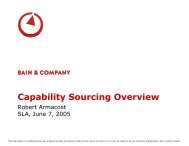Education Libraries - Special Libraries Association
Education Libraries - Special Libraries Association
Education Libraries - Special Libraries Association
Create successful ePaper yourself
Turn your PDF publications into a flip-book with our unique Google optimized e-Paper software.
that it is an excellent mechanism for students to<br />
synthesize all of the resources they are exposed to<br />
in the course and to apply them to a real world<br />
learning experience for their students. Students in<br />
the course have significant latitude in how to<br />
construct their WebQuest. Because most of the<br />
students have little, if any, experience with web<br />
authoring tools such as Dreamweaver or Microsoft<br />
FrontPage, Microsoft PowerPoint was chosen as<br />
the application of choice because it is familiar to<br />
most students as well as usually supported by most<br />
school systems. A template was constructed in<br />
Microsoft PowerPoint which includes the primary<br />
components and framework for their WebQuest:<br />
Introduction, Task, Resources, Process,<br />
Evaluation, and Conclusion. In addition, the<br />
typical structure of a WebQuest has been slightly<br />
modified to include the components of Standards,<br />
Citations, and Teacher Notes to the framework.<br />
In the next module, students are oriented to the<br />
INFOhio resources which include approximately a<br />
dozen different databases, most of which are<br />
available in each school district within the state of<br />
Ohio as well as remotely. Resources are available<br />
for a variety of content areas and all grade levels.<br />
Although all teachers theoretically have access to<br />
the network in the state of Ohio via their school<br />
districts, for many of them, this is the first time<br />
they have either been exposed to these resources<br />
or have devoted time to exploring the contents and<br />
classroom applicability of the resources. A tenminute<br />
learning activity is assigned at this point.<br />
In this exercise students create a mini-tutorial that<br />
will train their students and/or colleagues in one of<br />
the INFOhio databases to answer a specific<br />
research question. All tutorials are expected to<br />
include the following elements: the database<br />
name, grade level, topic/subject area, essential<br />
question, applicable academic content standards,<br />
search steps, additional comments or helpful hints<br />
about how the database works. Students are<br />
required to develop the essential research question<br />
in this tutorial assignment in such a way that it fits<br />
in with the final WebQuest project. Examples of<br />
the learning activities are housed on the Educator<br />
page from the INFOhio website (INFOhio teacher,<br />
2008).<br />
Because not all PreK-12 students have computer<br />
access at home, and because schools are not open<br />
during evening hours, instructors are intentional<br />
about including the statewide public library<br />
consortium, the Ohio Public Library Information<br />
Network (2007.) Any resident of Ohio may obtain<br />
a library card that enables users to access many of<br />
the online sources available through this<br />
consortium from remote locations. While there is<br />
some overlap in the online offerings between<br />
OPLIN and INFOhio, there are unique offerings as<br />
well. Students in the course are given activities<br />
and time to explore the wealth of resources in<br />
OPLIN, and they are encouraged to incorporate<br />
these findings into their final WebQuests.<br />
The module on Effective Internet Searching<br />
changes frequently due to the volatile nature of the<br />
Internet. Students learn about search engine math<br />
and logic as well as the different types of<br />
searching tools such as search engines, directories,<br />
and meta search engines. In addition to exploring<br />
the advanced search features of Google, students<br />
are provided the opportunity to learn about, utilize<br />
and compare functionalities between other search<br />
engines such as Ask.com and Dogpile.com.<br />
In aligning the course structure with the tenants of<br />
information literacy competencies, a module is<br />
included on the ethical and responsible use of<br />
information and explores the topics of plagiarism<br />
and copyright infringement. This is an<br />
increasingly popular topic because instances of<br />
plagiarism have been and continue to be on the<br />
rise (McCabe, 1999). Teachers struggle with<br />
methods to detect and prevent acts of academic<br />
dishonesty. This class provides concrete strategies<br />
with the added benefit of meeting regularly with a<br />
group of professionals with whom they can<br />
exchange ideas and strategies to combat this<br />
problem. The notion that teaching ethical use of<br />
information is the responsibility of the English<br />
composition teacher at the high school level is<br />
dispelled. Everyone is encouraged to embrace this<br />
problem as well as model ethical use of<br />
information and multimedia in their teaching<br />
practices.<br />
<strong>Education</strong> <strong>Libraries</strong>, Volume 31, No. 2, Winter 2008 15



